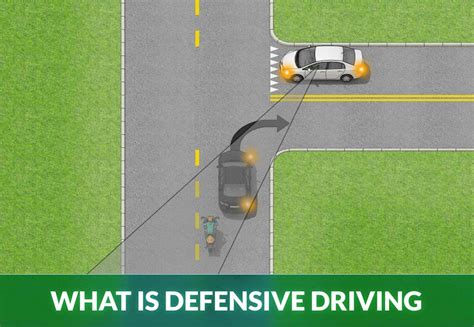Which Of The Following Is A Key To Defensive Driving

Defensive driving is an essential skill for all motorists, aimed at ensuring safety on the roads. It involves adopting a proactive and aware approach to driving, anticipating potential hazards, and making informed decisions to prevent accidents. This article delves into the concept of defensive driving, exploring its key principles and techniques, and offering practical insights to enhance driving safety.
Understanding Defensive Driving

Defensive driving is more than just following traffic rules and regulations. It is a mindset and a set of skills that empower drivers to recognize and respond effectively to potential dangers on the road. By adopting a defensive driving approach, motorists can significantly reduce the risk of accidents and contribute to a safer driving environment.
One of the fundamental principles of defensive driving is anticipation. Defensive drivers are always on the lookout for potential hazards, whether it's an erratic vehicle ahead, a sudden pedestrian crossing, or adverse weather conditions. By anticipating these potential risks, drivers can take proactive measures to avoid dangerous situations.
Key Techniques for Defensive Driving
There are several techniques that form the backbone of defensive driving. These include:
- Maintaining a Safe Following Distance: Defensive drivers ensure they keep a safe distance from the vehicle in front. This provides them with enough time and space to react in case of sudden stops or emergencies.
- Scanning the Environment: Instead of focusing solely on the road immediately ahead, defensive drivers scan the entire environment, including mirrors, to spot potential hazards early.
- Awareness of Blind Spots: Understanding and regularly checking blind spots is crucial. This helps drivers avoid unexpected collisions, especially when changing lanes or merging onto highways.
- Adapting to Weather Conditions: Defensive drivers adjust their driving style according to weather conditions. This includes reducing speed, increasing following distance, and being prepared for reduced visibility.
- Predicting Other Drivers’ Actions: Anticipating the actions of other drivers is a key skill. By observing their behavior and anticipating their next move, defensive drivers can be prepared for sudden lane changes or unexpected stops.
The Benefits of Defensive Driving

Adopting a defensive driving approach offers a multitude of benefits, including:
- Enhanced Safety: Defensive driving significantly reduces the risk of accidents, injuries, and fatalities on the road.
- Reduced Insurance Costs: Insurance companies often offer lower premiums to drivers with defensive driving certifications, recognizing the reduced risk these drivers pose.
- Improved Driving Skills: Practicing defensive driving techniques hones one’s driving skills, making drivers more confident and competent behind the wheel.
- Reduced Stress: By being proactive and prepared, defensive drivers experience less stress and anxiety while driving, leading to a more enjoyable driving experience.
The Role of Education and Training
Education and training play a vital role in promoting defensive driving. Many countries offer defensive driving courses, which can be beneficial for both new and experienced drivers. These courses provide practical training and insights, helping drivers develop the skills and mindset needed for safe driving.
Additionally, many insurance companies and driving schools offer online resources and materials to educate drivers about defensive driving techniques. These resources often include videos, interactive simulations, and written guides, making it easier for drivers to access and learn these essential skills.
| Defensive Driving Technique | Benefits |
|---|---|
| Maintaining a Safe Following Distance | Reduces the risk of rear-end collisions and provides time to react to sudden stops. |
| Scanning the Environment | Enables early detection of potential hazards, allowing for timely response. |
| Awareness of Blind Spots | Minimizes the risk of blind spot collisions, especially during lane changes. |
| Adapting to Weather Conditions | Ensures safe driving in adverse weather, reducing the risk of skidding or hydroplaning. |
| Predicting Other Drivers' Actions | Helps drivers anticipate and respond to sudden moves by other vehicles, preventing accidents. |

Conclusion: The Impact of Defensive Driving
In conclusion, defensive driving is a crucial skill that every driver should aspire to master. It empowers drivers to take control of their safety and the safety of others on the road. By adopting a proactive and aware driving approach, motorists can significantly reduce the risk of accidents and create a safer driving environment for all.
Whether you're a new driver or an experienced motorist, incorporating defensive driving techniques into your daily driving routine can make a significant difference in your safety and the safety of those around you. Remember, safe driving is a responsibility that we all share.
What are the key benefits of defensive driving courses?
+Defensive driving courses offer a range of benefits, including enhanced safety skills, reduced insurance costs, and improved driving confidence. These courses provide practical training and insights into various defensive driving techniques, helping drivers become more aware and proactive on the roads.
How can I improve my scanning skills while driving?
+Improving scanning skills involves actively looking beyond the immediate area in front of you. This means regularly checking mirrors, side views, and the road ahead, anticipating potential hazards. Practice makes perfect, so make it a habit to scan your surroundings frequently while driving.
Are there online resources available for learning defensive driving techniques?
+Yes, many insurance companies and driving schools offer online resources, including videos, simulations, and guides, to educate drivers about defensive driving. These resources provide an accessible way to learn and practice defensive driving techniques from the comfort of your home.



